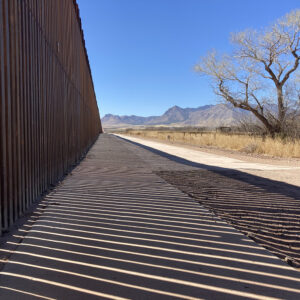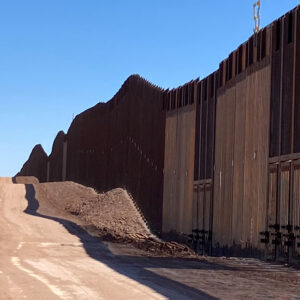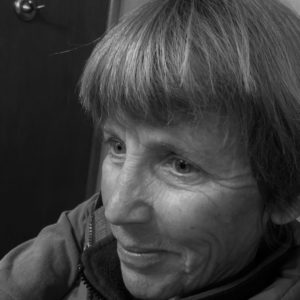 Something there is that doesn’t love a wall. These are the words of Robert Frost in his poem, “Mending Wall.” It’s been years since I sat down and read that poem. I spent most of the month of March thinking about walls and I was curious about what the old Vermonter had to say. If you’ve never read it, please do. Two neighbors are walking the wall between their properties. One of them is in favor of maintaining a visible and solid demarcation, and the other, the poet, wonders exactly why a wall is necessary. Good fences make good neighbors, claims the first man, yet the poet wonders, Why do they make good neighbors? Isn’t it/ Where there are cows? But here there are no cows.
Something there is that doesn’t love a wall. These are the words of Robert Frost in his poem, “Mending Wall.” It’s been years since I sat down and read that poem. I spent most of the month of March thinking about walls and I was curious about what the old Vermonter had to say. If you’ve never read it, please do. Two neighbors are walking the wall between their properties. One of them is in favor of maintaining a visible and solid demarcation, and the other, the poet, wonders exactly why a wall is necessary. Good fences make good neighbors, claims the first man, yet the poet wonders, Why do they make good neighbors? Isn’t it/ Where there are cows? But here there are no cows.
Because it’s National Poetry Month, I’ll tell you a little about Robert Frost. He wasn’t actually a Vermonter, or even a New Englander; he was born in California. And unlike the speaker in the poem, he did have cows. But because he disliked early to bed and early to rise, and because he had faith in the adaptability of his cows, he decided there was no reason to arise before dawn to do the milking, and repeat the milking twelve hours later at suppertime. Twelve hours was twelve hours, he figured, and his cows would be milked when he got up at close to noon. They would be milked again at close to midnight. He was smart with cows, Robert Frost was, as well as being a very good poet.
He was notoriously gruff, crabby, cranky. Did he choose his waking hours in order to minimize his contact with others of the human race? Yet his understanding of humans, their impulses, foibles, rages and griefs, was profound. Somewhere, he got the hang of humans, especially humans who live far away from cities, who depend on one another in times of need, and appreciate the natural world in which they live and toil. He was the first inaugural poet, reading at the inauguration of John F. Kennedy. It was the day before my eighth birthday, and I sat with my family in front of our black-and-white television set. In Washington, the wind was gusty and it caught the poet’s shaggy white hair and muffled his old, tired voice. Because of the brilliant winter sunlight, he had difficulty seeing the page, and finally he gave up on reading the poem he’d prepared and instead recited an old favorite, “The Gift Outright.”
Sixty years later I am studying my maps of southern Arizona, trying to find the best access to the border wall. I’m interested in particular in the wall I’ve come to think of as The Wall, the wall constructed during the last presidency, the iron symbol of that presidency. I’m not searching for the easiest access, but an approach that gives me ample time and space to feel I am far away from people, that I’m alone with The Wall, that it’s just me and it in a kind of clarifying communion. When he hears of my plan, my uncle Shep wants to join me, and together we map our route and set out walking the three miles to the Mexican border on a clear, hot March day.
Within a mile, we come across a pair of handcuffs in the dirt, and six abandoned backpacks full of shoes and water bottles. Farther along, a woman’s blouse is caught in the branches of a mesquite. From two miles away we can make out our destination: The Wall, a strange but distant intruder on the desert landscape, snaking over the shoulder of the Huachucas.
Something there is that doesn’t love a wall, but something there is that is fascinated by it. The dirt road leads right up to The Wall, and Shep and I slow down as we approach, both of us feeling many complicated emotions. Borders mark the intersection of so many things—dreams, delusions, love, hatred, family, culture, species—and this towering interruption of the continuity of landscape suddenly feels like an affront. We walk the last steps and lay our hands on the rusted steel bars. Shep drums a rhythm that echoes up and down the ribs of the behemoth. The Wall rises twenty-five feet from the ground, set in concrete in the floodplain of the San Pedro River. We walk east through its slatted shadow, and Shep points to the place where the river in flood has eroded the earth beneath the concrete. Soon it will be a tunnel for creatures to crawl through, and after that, a byway for people. The signs of impermanence here are not as difficult to find as I imagined. The tall, stout Wall intends to give the impression of unchallenged power, a unilateral decree, yet it can’t withstand the effects of time and water, a little rain in the desert. As if to second that, a great horned owl takes off from a nearby cottonwood, and in two great sweeping strokes rises up and over The Wall and disappears into Mexico.
At the end of “Mending Wall,” Frost describes the neighbor, the wall enthusiast: I see him there/ Bringing a stone grasped firmly by the top/ In each hand, like an old-stone savage armed./ He moves in darkness as it seems to me,/ Not of woods only and the shade of trees. The man’s own darkness, a darkness of spirit is the implication. And there is no mistaking the heavy darkness that disturbs the spirit here beside The Wall. It doesn’t matter whether it inspires a feeling of safety or a sense of dread, the incongruence of human will and natural inevitability is palpable. The one digs in, the other lets go. The one builds and rebuilds, the other follows the desultory streambeds of history. The one flashes and sings, the other endures, and nowhere is it so evident as here before The Wall.



